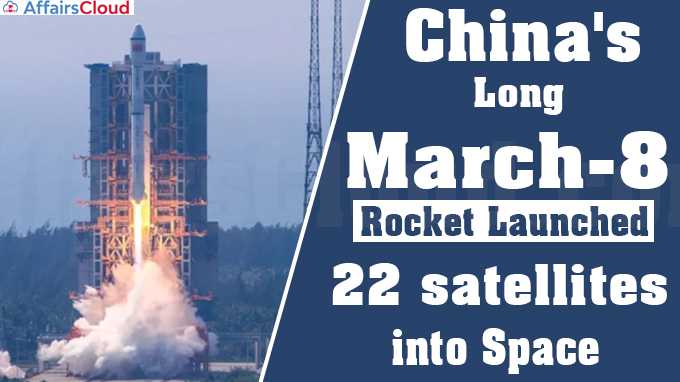
On 27th February 2022 China claimed a domestic record for the most spacecraft launched by a single rocket by launching a ‘Long March-8 rocket’ to place 22 satellites in space from the ‘Wenchang Spacecraft Launch Site’ in south China’s Hainan Province with the China Aerospace Science and Technology Corporation (CASC).
- The mission marked the 409th flight of the Long March carrier rockets.
- These satellites will be mainly used for commercial remote sensing services, marine environment monitoring, forest fire prevention and disaster mitigation.
- China set a new domestic record of 55 launches in 2021, surpassing the previous record of 39 launches in 2018 and 2020.
Background:
i.In April 2021, the China Great Wall Industry Corporation (CGWIC), a subsidiary of CASC, launched the first Long March Express rideshare using a Long March 6.
ii.In September 2021, a number of contracts for the new rideshare were signed at the Zhuhai Airshow .
About Long March 8:
i.The Long March 8 combines the 3.35-meter-diameter new-generation Long March 7 kerosene-liquid oxygen 1st stage with a 3-metre-diameter hydrolox 2nd stage from the older Long March 3A series.
ii.The 2nd Long March 8 has a length of 50.3 metres long and a mass at takeoff of 356 tons that flew without the pair of side boosters that was used in the rocket’s 1st mission.
iii.The payloads on the Long March 8 involved manufacturers with end users including 7 commercial companies and 2 research institutes.
Satellites launched:
i.Changguang Satellite Technology, a Changchun-based remote sensing constellation operator and spinoff from the Chinese Academy of Sciences’ CIOMP, launched 10 new Jilin-1 satellites for its constellation of remote sensing satellites of the same name.
- Satellites – Jilin-1 GF03D10-18 satellites (GF – Gaofen) or high resolution, with 8 satellites having a mass of around 43 kilograms each. Jilin-1 MF02A01 is a 32-kilogram multi-functional (MF) satellite to test a new platform.
ii.Small satellite maker Mino space manufactured 5 satellites aboard the mission.
- Taijing-3 (01) 240-kilogram optical and Taijing-4 (01) 250-kilogram synthetic aperture radar (SAR) satellites will be operated by Mino space.
- It also made the Wenchang-1 (01) and Wenchang-1 (02) wide-field multispectral satellites for the Sanya Institute of Remote Sensing and Hainan Westar Remote Sensing Technology Application Service with a mass of 62.5 kilograms each.
- The Xidian-1 hyperspectral remote sensing satellite for the new Silk Road Tiantu constellation that is operated by Shaanxi Silk Road Tiantu Satellite Technology.
ii.Changsha-based commercial spacecraft maker and constellation operator ‘Spacety’ launched the Chaohu-1 satellite, the 1st of the planned Tianxian SAR constellation in cooperation with the China Electronics Technology Group (CETC).
- The 325-kilogram satellite builds on the Hisea-1 SAR satellite launched on the previous Long March 8 flight.
- Spacety also had the 14-kilogram Thor Smart Satellite on the mission that carries a distributed software protocol test payloads and three GRID gamma ray burst detectors and the Aurora-2 X-ray polarimeter.
iii.Tianqi-19, manufactured by Shandong Institute of Aerospace Electronics Technology for Guodian Gaoke and its Tianqi low-Earth orbit narrow-band Internet of Things constellation.
iv.Shenzhen Aerospace Dongfanghong Satellite developed 60-kilogram Hainan-1 (01) and Hainan-1 (02) satellites under the ownership of CASC, for Hainan Westar Remote Sensing Technology Application Service.
- The satellites carry imagers and automatic identification system (AIS) receivers for maritime surveillance.
v.Star Era-17 (Xingshidai-17), also referred to as ‘Dayun’, the Chinese name for the Universiade international sports event to be held in 2022 in Chengdu, is a 20-kilogram satellite carrying visible light and thermal infrared imagers and ‘AI payloads’
- This is developed and operated by ADA Space, based in Chengdu, southwest China.
vi.Wuhan University developed the Phospherus-1, a 22-kilogram optical satellite for hyperspectral imaging.
Note – In February 2022 China launched the L-SAR 01B satellite on a Long March 4C, sending the synthetic aperture radar satellite to operate in formation with the L-SAR 01A satellite, which was launched in January 2022.
Recent related news:
China has successfully launched its 1st solar exploration satellite into space from the Taiyuan Satellite Launch Centre in northern Shanxi Province aboard a Long March-2D rocket.The satellite was named as ‘Xihe’(Xihe is the goddess of the sun who created the calendar in ancient Chinese mythology), also known as the Chinese Hα Solar Explorer (CHASE).
About China:
Capital – Beijing
Currency – Renminbi
President – Xi Jinping




